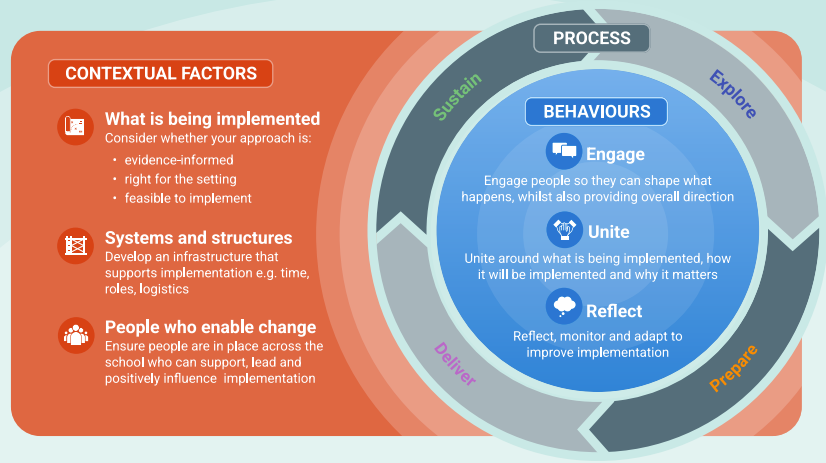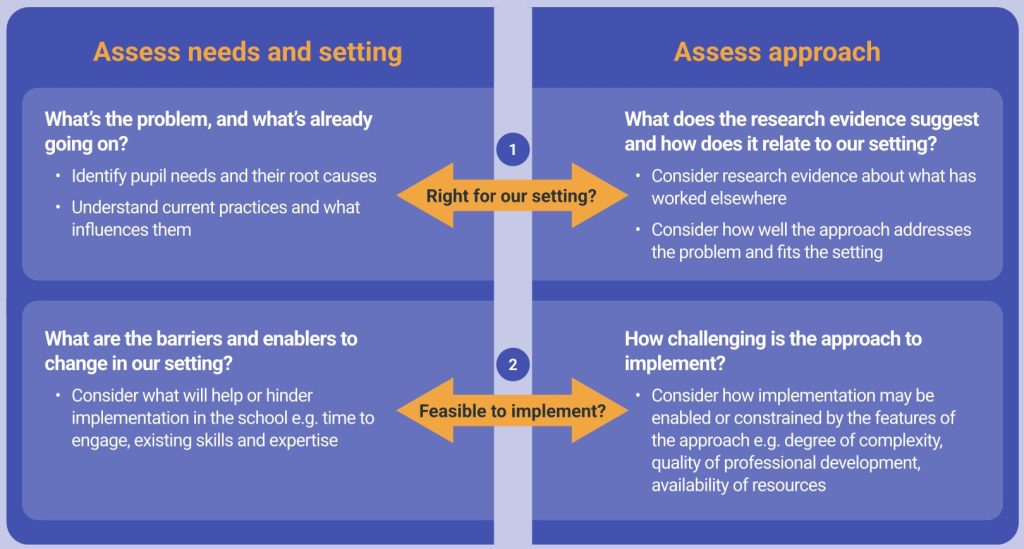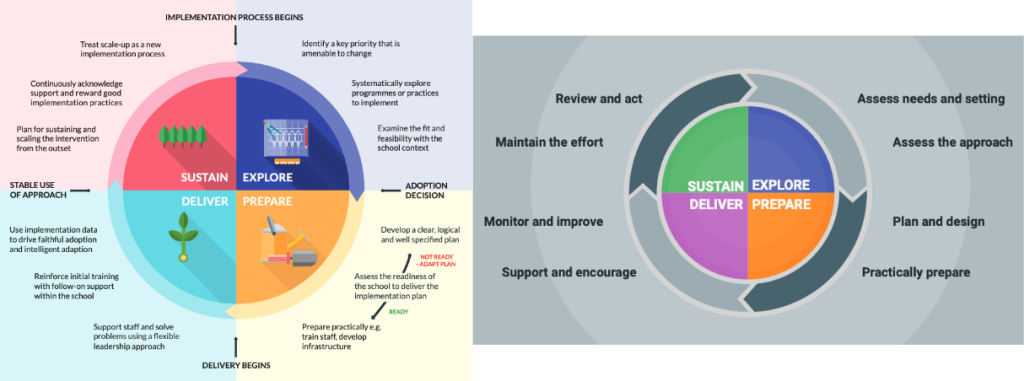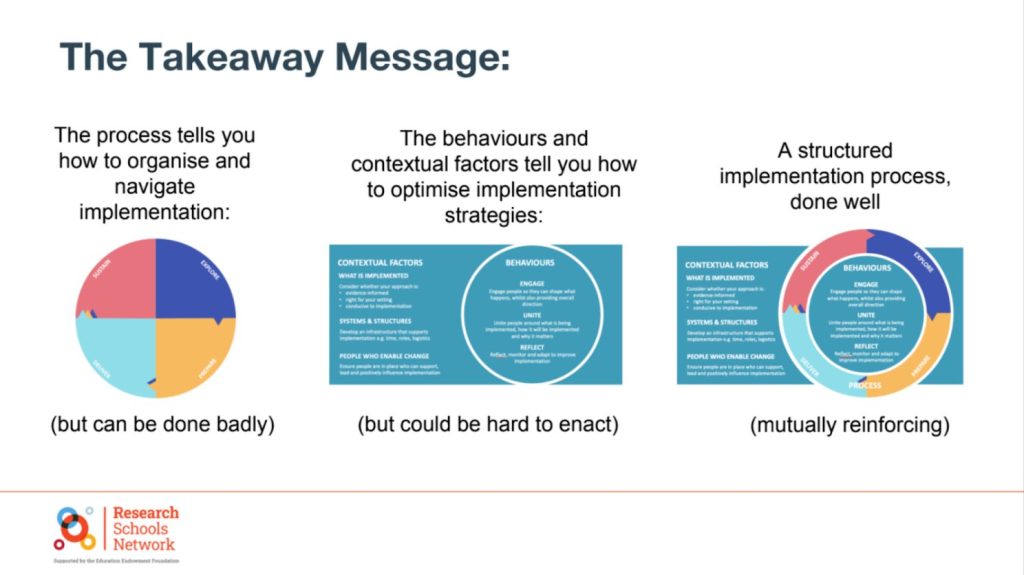4 June, 2024
EEF's implementation guidance for schools 2024
This article is written by Complete Mathematics about the updates on the original guide of the Education Endowment Foundation (EEF) supporting schools in the implementation of new approaches and practices.
Updates to EEF’s A School’s Guide to Implementation
This article is written by Complete Mathematics, a company that works in partnership with leaders of schools and school groups looking to improve attainment in mathematics, embedding evidence-based approaches through platforms and expert CPD which apply beyond mathematics.
Wondering how the EEF’s new implementation guidance for schools has changed?
Policy specialist of Complete Mathematics, Rebekah Fant-Male, has compared the frameworks and analysed what the changes in advice mean for you.
In 2019, the Education Endowment Foundation (EEF) updated their original guide supporting schools in the implementation of new approaches and practices. In May 2024, they updated their guidance. This article summarises key changes of particular relevance for school and system leaders.

Executive Summary of Updates
Stages to Phases
EEF’s 2019 update to “A School’s Guide to Implementation” defined implementation as a process with stages set out in a very rigid, linear structure. The new guidance takes a different approach, representing Explore, Prepare, Deliver, Sustain as phases, subtly shifting their scope to enable greater flexibility in how leaders think about implementation.
Significance of the Changes
This is not just updating references, but a significant shift in how schools do implementation, although in focus rather than content.
In one sentence, whereas the previous guidance supported school leaders to do implementation, this is how school and system leaders can do implementation well.
Behaviours and Context FIRST
The previous 6 Recommendations have been condensed into 3. New Behaviours (Recommendation 1) and Contextual Factors (Recommendation 2) underpin successful implementation and precede the familiar Implementation Phases (Recommendation 3).
The Behaviours – Engage, Unite and Reflect – are explicitly interwoven throughout the guidance, while greater emphasis on Contextual Factors encourages leaders to reflect on existing structures and systems. Rather than layering additional demands, this change encourages implementations which connect into what is already in place where possible to embed changes more effectively.
Tammy Elward, Director of the Derby Research School and the Spencer Teaching School Hub considers the value of the guidance for Multi Academy Trust Leaders:
“Anchoring our practice in evidence as leaders is a challenge because it’s not just what we do, but the way that we do it that makes the difference. The new guidance report captures the key aspects from a wide range of research sources and codifies them into a clear framework for us as leaders to think really carefully about how we lead change in our schools and make the biggest difference for our pupils.”
A Focus on Feedback
Contextual analysis
Under this guidance, there is less scope for leaders to deterministically implement an intervention they already believe to be the best solution, without undertaking sufficient analysis. However, to mitigate this further, I would prefer to see ‘What is being implemented’ as the final contextual factor (see below), rather than the first.

The figure above presents how the three recommendations integrate throughout implementation. I would simply caution, in line with the update’s shift towards a more flexible framework, against carrying forward a mindset of implementation as a linear process. Interventions should result from an analysis of the contextual factors surrounding the perceived “problem” or need, encapsulated by the Reflect behaviour, rather than being determined before existing systems, structures and people have been duly considered.
Iona Jackson, Head of Insights at Edurio, evidences the importance of using feedback authentically, from their national survey data:
“In 2022/23, about one third of staff (34%) said that their feedback to the leadership always or often has an impact. However, about one in four (27%) of staff said that their feedback rarely or never has an impact.”
Retention is one of the most pressing current issues for school systems in the UK and globally and Edurio also found that,
“…only 17% of staff with a high risk of resignation always or often see that their feedback to the leadership has an impact, while 48% of staff with a low risk of resignation always or often see that their feedback to the leadership has an impact.”
EEF (2024) also emphasises that, “stress and burnout can be damaging for individuals and prove a barrier to implementation… particularly relevant during the initial delivery period if staff are inexperienced or if key people leave a project” (p40).
Of practical relevance for implementation leaders, Ms Jackson tells us that Edurio’s recent report Leadership Strategies in School Trusts involved,
“interview[ing] leadership teams with leadership scores above national benchmarks in Edurio data. We found that although approaches may differ, open, clear and consistent communication, as well as proactive problem-solving through collaboration, were all mentioned by top leadership teams.”
Fit and Feasibility
Explore Phase: EEF’s updated tool (p.25) roots the implementation decision-making process in the needs and context. The phrase ‘fit and feasibility’ is retained and brings to the fore ‘insights and perspectives… from across the school community – staff, pupils, parents’ (p.23) to avoid preconceptions. It acknowledges informal conversations as a source of data about the school context, alongside external data on what has worked in similar contexts. This should prompt richer reflection on the implications of potential interventions on the wider school context.

Fit and feasibility return in Prepare, to consider competing initiatives, and in Sustain. Rather than “How will the initiative be scaled?” the question is instead, “On reflection, should we sustain, scale or de-implement this approach?”
Readiness: Reflection on barriers and enablers of change has moved from Prepare to Explore, sensibly determining the school’s readiness for change prior to writing an implementation plan. As contextual factors, reflection on structures and elements of culture which help or hinder change are threaded through the update’s implementation phases. In this way, readiness is not confined to a single point in a process, but a state that might change, due to factors within or beyond a leader’s control. For example, government policy might necessitate new implementations, requiring thought as to whether new changes might be integrated within implementation plans, or potentially de-implemented.

‘Successful’ Implementations
Fidelity and Flexibility
I am pleased to see this update taking a more nuanced approach to implementation fidelity, based on research which suggests adaptations can lead to more effective embedding of change.
The language of deciding where to be “tight” and where to be “loose” is retained. Meanwhile, “active ingredients” have become “core components”. This terminology prompts leaders to define which elements teachers should apply consistently – those “core” to avoiding lethal mutations, whilst allowing flexibility for (some) adaptations by teachers as professionals in complex contexts.
Leaders might consider core components as they plan how implementation outcomes will be monitored and shared in order to retain both flexibility and fidelity.
Iona Jackson adds insights Edurio uncovered on cultures encouraging collective expertise, where leaders listen to feedback and allow it to shape their decision-making to truly impact their communities.
“A significant piece of advice from Gavin Booth, CEO at Infinity Academies Trust, is promoting a culture where seeking help and guidance is seen as a strength rather than a weakness. This approach challenges the misconception that to be effective, leaders must operate independently. He questions, ‘Why have you done this on your own? You didn’t need to do this on your own; we would have helped to do that.’ This sentiment underscores the importance of collaborative efforts and leveraging collective expertise within a trust.”
Interwoven Behaviours and Contextual Factors
Unite, Engage and Reflect behaviours are continually and explicitly referenced throughout the guidance. Opportunities for teachers and leaders to collaborate and reflect together are made more explicit than in previous versions, with greater emphasis on systems and structures which remove other pressures from teacher workload gleaned from listening to teacher feedback, such as removing administration tasks and ‘prun[ing] competing initiatives’ (EEF, 2024, p.39).
Conclusions
The EEF’s update sends a clear message: analyse your context and culture; develop structures which give teachers the time and resources to engage with the intervention; unite around the implementation process and reflect together at every phase.
The three facets of the original Implementation Process, in combination with Behaviours and Contextual Factors exemplify the purpose to support leaders not to just do implementation, but to do it well. Tammy Elward sums up how the behaviours and contextual factors reinforce the implementation process as follows:

To learn more from Derby Research School about how to apply the new guidance, register for their Summer Webinar Series, starting 22nd May.
Edurio’s new resource, “Leadership Strategies in School Trusts”, explores what it takes to be a high-achieving leader in a Multi-Academy Trust (MAT). The guide includes sections on Leadership structures and styles, practice and impact, challenges and solutions, and advice to leaders.
